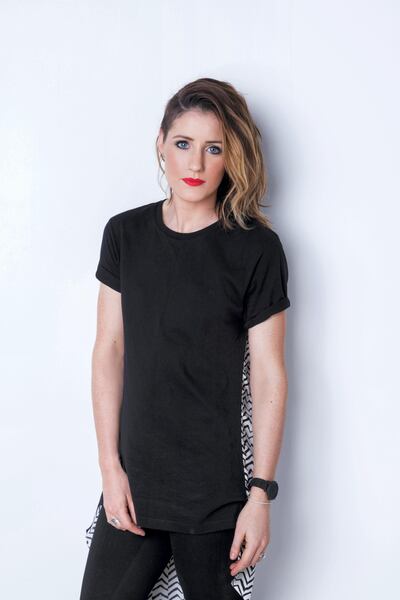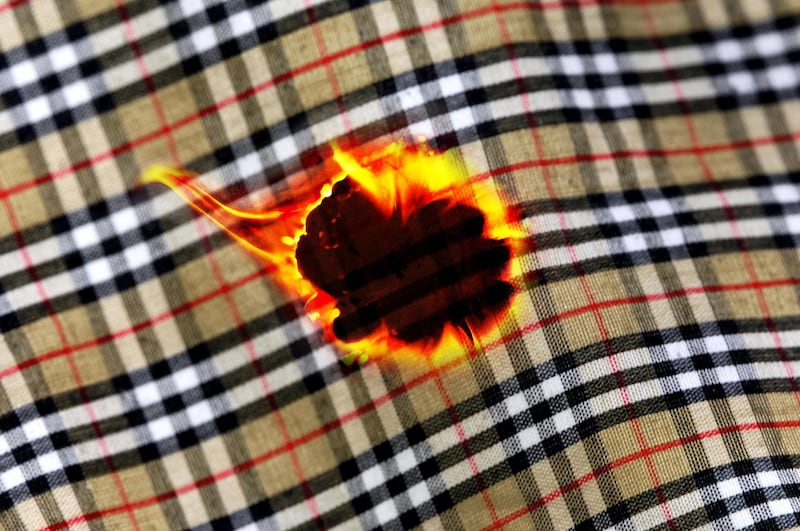It was a small group of statistics buried in Burberry's 200-page annual report that caused all the outrage. But while the numbers referenced with the line "finished goods physically destroyed during the year" were just business as usual for the fashion industry, to everybody else it was US$35.6 million (Dh130.7m) worth of luxury products going up in smoke. In revealing that it burns unsold clothes and cosmetics to prevent the brand from entering the "grey market" – where items are sold at knockdown prices from unofficial retailers – Burberry does offer a caveat.
The brand says that it disposes of items in an environmentally friendly manner, harnessing the energy from it during the process. It was an explanation that did little to douse the flames rising on social media, digital ire combining furiously with pithy hashtags (#Burnberry, anyone?).
How has Burberry done the fashion industry a favour?
But perhaps the British heritage brand has inadvertently done the fashion world something of a favour. Through its overt transparency, a multibillion-dollar industry that has long been riddled with bad practice and waste, could finally be required to account for its actions.
“The fact that Burberry destroys stock is not a surprising revelation for those with knowledge of the industry,” explains Sass Brown, dean of Dubai Institute of Design and Innovation. “This has been a long-time practice to ensure the exclusivity of product.”

It would literally rather burn something than let you take it home for less
So, while a brand may have an excess of stock, unless you can afford to stump up the high prices you’ll have to go without. This is what creates the false need, and the illusion of scarcity. It’s what makes you agonise over a product until you would do anything to own it. It’s also part of the reason that brands are left with the excess stock in the first place: your average consumer just can’t afford to buy it. But then the luxury market doesn’t want “average”, and it would literally rather burn something than let you take it home for less. But this method isn’t just the sole preserve of luxury brands. “It’s important to recognise it’s not just Burberry,” explains Orsola de Castro, founder and creative director of Fashion Revolution, a collaboration of designers, consumers, academics, retailers and policymakers striving for an industry shift towards sustainability. “They actually score reasonably well in our Fashion Transparency Index and champion lots of good sustainability initiatives. The problem is a direct consequence of mass production, and many other luxury brands and high-street brands are doing it, too.”

Brown agrees. "This isn't exclusive to the luxury apparel industry, but is seen at all sorts of accessories and cosmetics brands, as well as high-street retailers. Nike and H&M were both reported last year for destroying stock, rather than discounting it, for the same reasons," she says. Last year, The New York Times reported on garments it found destroyed and discarded outside the retailers' outlets in New York.
Why is Burberry so protective over its products?
Regardless of the reality of fashion’s dark little (open) secret, Burberry is taking the brunt of the fallout. But then it’s no stranger to brand crisis. In 2000, its signature plaid was co-opted by a British subculture prone to antisocial behaviour and given the moniker “chav” in the United Kingdom. It led to the iconic tartan being copied and used on everything from pram linings to car seat covers. Burberry responded by reducing its output and having a major brand shift, successfully led by Christopher Bailey. As a result, you can almost forgive it for being a little skittish when it comes to where its products end up.

While it might be the burning of unsold products that has the world talking, the reality is that it’s simply a by-product of mistakes made much earlier in the fashion chain. How the industry forecasts sales and deals with waste are in dire need of an overhaul. “Forecasting production and purchasing has always been a very risky business,” explains Brown. “It’s based on the previous year’s sales figures, and therefore can only be an estimate of needs. You lose sales if you underproduce and end up with excessive stock if you overproduce. The current fashion system dictates this need. I’m a huge supporter of alternatives to the mainstream solutions, such as season-less collections, zero-waste cutting, made-to-order items and a host of other responses.
“Unfortunately, big brands like Burberry are locked into a broken system, part of which is financial. As a publicly traded company, it is expected to show continuous growth on a quarterly basis. But how can a brand show constant and consistent growth on a finite planet, despite financial downturns, material scarcity, changing weather patterns and a host of other market realities?”
What a waste
If surplus garments are an example of a broken financial system, waste is endemic of a broken fashion system. "There's actually much more waste produced through the production of goods to begin with," continues Brown. "Most production is a result of what we call a detractive system, which in the case of clothing means you cut out the pieces you want from a length of fabric to make a garment and throw away what's left, resulting in an average of about 15 per cent waste of virgin materials. That waste is replicated along the entire textile supply chain, from raw material growth or production, through spinning, weaving, dying, printing and manufacturing."
What’s perhaps surprising is that this isn’t new information. The issue of waste in the fashion industry has long been known, prompting global initiatives such as the Make Fashion Circular campaign by the Ellen MacArthur Foundation, which aims to ensure clothes are made from safe and renewable materials, and that old clothes are turned into new garments. “The fashion industry as a whole needs a complete, systemic redesign,” says Francois Souchet, Make Fashion Circular lead. “Every year 53 million tonnes of fibres are used to make clothes, and 73 per cent of those fibres will go on to be landfilled or incinerated. Another 12 per cent is lost in production and 0.5 million tonnes of microfibres leak into the ocean. Less than 1 per cent is recycled back into new clothes.
“Not only is the fashion industry creating waste, but greenhouse gas emissions from textile production total more than all international flights and shipping combined – 1.2 billion tonnes a year. If it continues to produce clothing in the same, wasteful way, textile production will account for 26 per cent of the world’s carbon budget in 2050.”
Can it be fixed?
Whether fashion’s wasteful habits can ever truly be overturned is open to debate. Perhaps a more realistic opportunity for change lies in the education of emerging designers. At the Dubai Institute of Design and Innovation, the environmental impact of a designer’s choices makes up a major component of their course. For those already in the field, however, it’s a matter of shifting traditional focus.
Deborah Henning, a designer living in Dubai whose eponymous label launched in 2014, has already seen a change in attitude. “When I began, the focus was to develop an aesthetic and product, and build a brand. Now, almost five years on, I’m able to redirect the ethos and factor in elements that match the type of business that I’d like to have in the future. It’s every business owner’s responsibility to have a focus on sustainability, so in my mainline collection, minimalism isn’t just an aesthetic, it extends to the design and development of the pieces. We keep classic styles on rotation, slowing the fashion chain down and promoting a buy-less and buy-well concept. We also use ethically sound and sustainable fabric sources as much as possible. As the company grows, so will the environmental decisions.

Brown believes that collaboration could be the answer. “I would love to see big brands and luxury labels make strategic partnerships to redesign and reuse their damages, waste and unwanted stock as a means of revaluing them, instead of destroying them. Hermes has done a version of this with Petit h, where the brand repurposes Hermes’s leftover stock through artist collaborations. There’s a major opportunity for high-street brands to strike up designer collaborations to repurpose their stock and then sell them amid major fanfare and limited editions – how about Stella McCartney reusing H&M waste?
“Luxury brands could gift their leftover materials to emerging designers aligned with their aesthetic as a means of supporting the next generation while repurposing waste. The elimination of waste is a far more sustainable response, but it’s a more difficult one that requires major changes in not only business practices, but also consumption.”
That last point is one we perhaps don’t really want to acknowledge. While the world has been quick to point the finger at Burberry and the industry as a whole, it’s important to remember that we, the consumer, are culpable, too. We need to examine how we shop if we’re to play our part in affecting change. “We live in such a disposable society that we’re always craving more,” says Patrick Duffy, founder of Global Fashion Exchange. “In that sense, the consumer is as much to blame as the producer. If we change our habits, the fashion houses and shops are all going to have to respond accordingly. If we stop buying from these outlets because of their practices, I’m sure we’d see a very quick shift in their approach.”
How to be a sustainable designer
Global Fashion Exchange supports sustainability in the fashion industry through clothing swap events, curated talks and cultural activations. Its founder, Patrick Duffy, offers advice on better practices to the next generation of designers

1. Only use material from an ethical textile manufacturer, making sure their practices align with Modern Slavery acts.
2. Use natural and biodegradable materials, such as organic cotton, wool and linen.
3. Try to avoid plastic-based or chemically treated textiles. Microfibres expelled from these materials flow through wastewater systems into our oceans, when washed, and are consumed by marine life. Currently 83 per cent of all our water, including rainwater and bottled water, contains microfibres and plastic – 38 percent of this comes from the fashion industry.
4. Reuse and recycle unsold stock. To destroy it is not only adding to the global toxins, but also a waste of resources.
5. Get creative. There will always be offcuts in the design workshop that can be recycled or used to create other products, such as padding for furniture and mattresses, and insulation for cars and roofs.
The next Global Fashion Exchange swap takes place in September. For details, visit www.globalfashionxchange.org
_________________________
Read more:
Amir Meghani: the man who makes his own diamond watches
[ From Kareena to Kangana: our favourite looks from India Couture Week ]
[ In or out? Manchester City squad's schoolboy-style shoes and socks ]
_________________________





